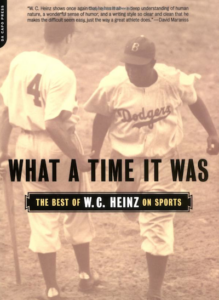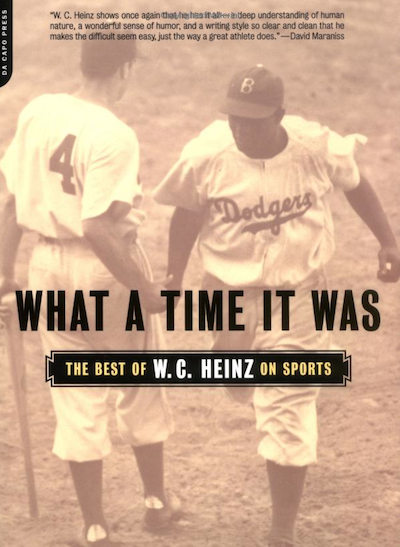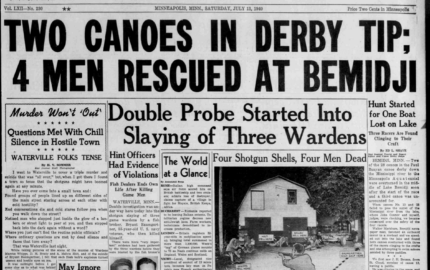Narrative isn’t synonymous with long-form work. A narrative journalist doesn’t need thousands of words or loads of reporting and writing time to tell a memorable story. For you hunter-gatherers of short-form models, consider:
 W.C. Heinz's “Death of a Racehorse.” At 963 words, it is one of the most glorious short narratives ever written. A glimpse:
W.C. Heinz's “Death of a Racehorse.” At 963 words, it is one of the most glorious short narratives ever written. A glimpse:
Larry Bingham's “The 99-Year-Old Man Who Learned to Read,” 826 words of restrained beauty from the Fort Worth Star-Telegram:
The legendary Atlanta Constitution editor Gene Patterson, who won the 1967 Pulitzer Prize. Patterson, who died in January, infused his groundbreaking editorials with narrative elements. (For an extra treat, read Nieman Foundation curator Ann Marie Lipinski's Nieman Reports piece on the crossover between Patterson and the late web prodigy Aaron Swartz.) “This body of work is one of the most important epics in the history of American journalism, even in this country’s history,” Poynter's Roy Peter Clark has written of Patterson’s 3,200 columns, which appeared in the Constitution between 1960 and 1968. Clark, in a craft essay that distinguishes stories from articles, uses Patterson to show how narrative techniques – scene, detail, dialogue, symbolism – can enliven any space:
Let us know if you have a favorite short narrative – and why you admire it – and we may add it here.
 W.C. Heinz's “Death of a Racehorse.” At 963 words, it is one of the most glorious short narratives ever written. A glimpse:
W.C. Heinz's “Death of a Racehorse.” At 963 words, it is one of the most glorious short narratives ever written. A glimpse:The boy in the van with the colt led him out then, the colt limping, tossing his head a little, the blood running down and covering his left foreleg. When they saw him, standing there outside the van now, the boy holding him, they started talking softly.
"Full brother of Assault." ... "It don't make no difference now. He's done." ... "But damn, what a grand little horse." ... "Aint he a horse?"
Larry Bingham's “The 99-Year-Old Man Who Learned to Read,” 826 words of restrained beauty from the Fort Worth Star-Telegram:
The old man got by without reading for 98 years. He trusted the people who paid his wages, had no need for books or bank accounts, and his wife read the bills.
He married twice, was widowed twice, and raised seven children. All of them learned to read and write at Lincoln High School, a few blocks from his house. "I seen to 'em, every one. I didn't get to go to school, so I seen to them."
The legendary Atlanta Constitution editor Gene Patterson, who won the 1967 Pulitzer Prize. Patterson, who died in January, infused his groundbreaking editorials with narrative elements. (For an extra treat, read Nieman Foundation curator Ann Marie Lipinski's Nieman Reports piece on the crossover between Patterson and the late web prodigy Aaron Swartz.) “This body of work is one of the most important epics in the history of American journalism, even in this country’s history,” Poynter's Roy Peter Clark has written of Patterson’s 3,200 columns, which appeared in the Constitution between 1960 and 1968. Clark, in a craft essay that distinguishes stories from articles, uses Patterson to show how narrative techniques – scene, detail, dialogue, symbolism – can enliven any space:
On Sept. 16, 1963, he published a column called, “A Flower for the Graves.” It is argument, but it also has a story. It starts with a scene, a moment in time:
A Negro mother wept in the street Sunday morning in front of a Baptist Church in Birmingham. In her hand she held a shoe, one shoe, from the foot of her dead child.
He introduces a detail that immediately becomes a symbol: a child’s shoe:
We hold that shoe with her. Every one of us in the white South holds that small shoe in his hand.
In these first four sentences, Gene Patterson took his audience of white Southerners from whatever emotional, political, geographic place they resided, and transported them to 16th Street in Birmingham.
Let us know if you have a favorite short narrative – and why you admire it – and we may add it here.



